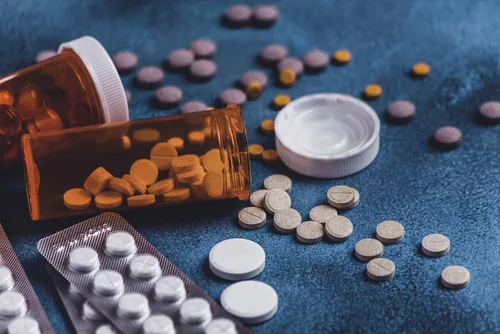Overview of Stimulants

Stimulants are a large class of drugs characterized by their ability to increase alertness, arousal, and attention. Some are effective treatments for psychiatric and other medical conditions, while others are only used illicitly. As a class, stimulants share the potential for addiction and carry the risk of potentially serious side effects. This article provides an overview of stimulants, available agents, relevant pharmacology, and approaches to managing patients with stimulant use disorder (StimUD
A brief history of stimulants
Stimulants have been used since prehistoric times (Hagen EH and Tushingham S. The Prehistory of Psychoactive Drug Use. In: Henley TB et al, eds. Handbook of Cognitive Archaeology. New York, NY: Routledge; 2019:471–498). In modern medicine, their use dates to the 19th century, when they were prescribed for indications as varied as anesthesia, weight loss, and asthma. Famously, cocaine was even included in the original Coca-Cola. However, by the 1950s, the risk of addiction and other adverse effects became evident, leading to increasingly restricted access and culminating with the passage of the Controlled Substances Act in 1970 (www.tinyurl.com/578am5xn).
Recently, stimulants have been implicated in a growing number of drug overdose deaths. Since 2019, overdose deaths involving stimulants have risen annually, now comprising a third of all overdose deaths in the US (O’Donnell J et al, MMWR 2020;69:1189–1197). This “fourth wave” of the drug overdose epidemic is driven by the contamination of stimulants with fentanyl and its derivatives, exposing people unexpectedly to opioids. One study found fentanyl in nearly 10% of illicit stimulants, particularly cocaine and methamphetamine (Wagner KD et al, Drug Alcohol Depend 2023;252:110985).
Pharmacology
Most stimulants, whether FDA approved or used recreationally, increase levels of the catecholamine neurotransmitters dopamine and norepinephrine. Some have additional mechanisms of action, like the serotonin agonism of MDMA, while others, such as caffeine and nicotine, work altogether differently. Pharmacologic properties that influence the addictive potential of stimulants include:
Potency
High-potency stimulants are more reinforcing. For example, methamphetamine produces much more powerful dopamine release than amphetamine, contributing to its greater addictive potential (Goodwin JS et al, J Biol Chem 2009;284(5):2978–2989).
Pharmacodynamics
Stimulants with rapid onset and short duration of action tend to be more reinforcing. Smoked crack cocaine, which reaches the brain in less than 10 seconds and peaks within minutes, is more addictive than intranasal cocaine, which takes longer to be absorbed and lasts up to 30 minutes (Bravo RR et al, Toxins 2022;14(4):278).
Prescription stimulants
Prescription stimulants, primarily FDA approved for the treatment of ADHD, are based either on methylphenidate or on amphetamine. Methylphenidate comes in:
- Immediate-release forms (Ritalin, Methylin, Focalin)
- Extended-release forms (Concerta, Relexxii)
- A transdermal patch (Daytrana)
Amphetamines come as:
- A racemic mixture of amphetamine salts (Adderall, Mydayis)
- A pure form of the D-isomer (Dexedrine, Zenzedi)
- Lisdexamfetamine (Vyvanse), a prodrug metabolized into dextroamphetamine by enzymes in red blood cells
 See “FDA-Approved Stimulant Medications” table for an overview of FDA-approved stimulants.
See “FDA-Approved Stimulant Medications” table for an overview of FDA-approved stimulants.
Despite their effectiveness, these drugs have the potential for addiction and serious side effects. Before starting a stimulant, establish a firm diagnosis and inform the patient of the risks. Stimulants are associated with modest increases in heart rate and blood pressure, so a careful cardiac history is warranted. Consult a cardiologist before starting a stimulant in patients with:
- History of syncope
- Chest pain
- Severe dyspnea on exercise
- First-degree relative who had sudden cardiac death
- Tachycardia or irregular heart rate on cardiac auscultation
- Clinical signs or diagnosis of Marfan’s syndrome (taller than expected, long extremities, hyperextendable joints, pectus deformity)
Finally, monitor for misuse and check your state’s prescription monitoring program to ensure patients aren’t “doctor shopping.”
Illicit stimulants
The most common illicit stimulants include:
- Cocaine—Used intranasally, smoked as “crack,” or injected.
- Methamphetamine—Often sold as “crystal meth” due to its glass-like appearance; has a longer half-life than cocaine and a greater propensity to cause psychosis. Most frequently smoked but can be snorted and injected.
- MDMA—An amphetamine derivative with empathogenic and psychedelic properties. Usually taken by mouth.
- Synthetic cathinones (“bath salts”)—Highly potent and often containing a mixture of drugs, leading to aggression and psychosis during intoxication. Usually smoked or snorted; can be injected, swallowed, or used rectally.
 Psychoactive and physical effects
Psychoactive and physical effects
These stimulants produce a rush of euphoria, energy, and enhanced concentration. Effects vary by half-life—methamphetamine has a half-life of four to eight hours resulting in effects that can last a day or more, compared to cocaine with a half-life of 15–30 minutes and effects lasting not much beyond an hour. See “Stimulant Drugs Not FDA Approved or Rarely Used Medically” table for an overview of these drugs.
Unlike alcohol or opioids, people generally use stimulants intensely for a short period, called a “run” or “spree.” The period following the run, the “crash,” is characterized by depression, anhedonia, low energy, and cravings to use again Moreover, research suggests this risk is dose dependent, with higher doses associated with higher risk of psychosis (Moran LV et al, Am J Psychiatry 2024;181(10):901–909).
High doses can cause manic and psychotic symptoms that typically subside with abstinence but can persist for months, especially with more frequent use. Stimulant use is associated with primary psychotic disorders (Toscano ER et al, Schizophr Bull 2023;49(5):1269–1280). Chronic use can lead to dopamine depletion, resulting in a Parkinson-like syndrome, severe dental issues (“meth mouth”), and loss of body weight, particularly muscle mass. Cardiovascular consequences include hypertension, cardiomyopathy, and heart failure, as well as increased risk of myocardial infarction and stroke (Cardiovascular consequences).
Treatment
No FDA-approved medications exist for StimUD, but some agents show promise, including bupropion with and without naltrexone, mirtazapine, and topiramate (see CATR May/June 2021 for a review of medications for StimUD). Psychotherapy can be effective, particularly modalities that incorporate a behavioral component such as cognitive behavioral therapy and contingency management (see our interview with Dr. DePhilippis in this issue for more). Trials examining whether prescription stimulants can be used to treat StimUD have been mixed, with some showing small benefits and others not (Tardelli VS et al, Psychopharmacology 2020;237(8):2233–2255). Currently, there is no high-quality evidence to recommend this as a general practice.
Harm reduction strategies
Harm reduction measures can decrease the morbidity and mortality associated with stimulant use, regardless of whether your patient is ready for abstinence. They include:
- Drug testing—Fentanyl test strips are a quick and inexpensive way to test for the presence of fentanyl. Learn about fentanyl testing in CATR July/Aug/Sept 2023.
- Naloxone distribution—Provide naloxone in case of unintended opioid exposure.
- Safer use supplies—Sterile needles and new smoking equipment reduce the risk of HIV, hepatitis C, soft tissue infections, and burns.
- Never Use Alone hotline—Patients can call this number (1-877-696-1996) to send emergency services if needed.
Carlat Verdict
Stimulants represent a broad array of substances, ranging from FDA-approved medications to highly potent drugs that are exclusively used recreationally. An understanding of the pharmacology, risk, and treatment options for stimulants is important when managing patients with StimUD. Whenever possible, use evidence-based treatments for these patients combined with effective harm reduction measures.




_-The-Breakthrough-Antipsychotic-That-Could-Change-Everything.webp?t=1729528747)



